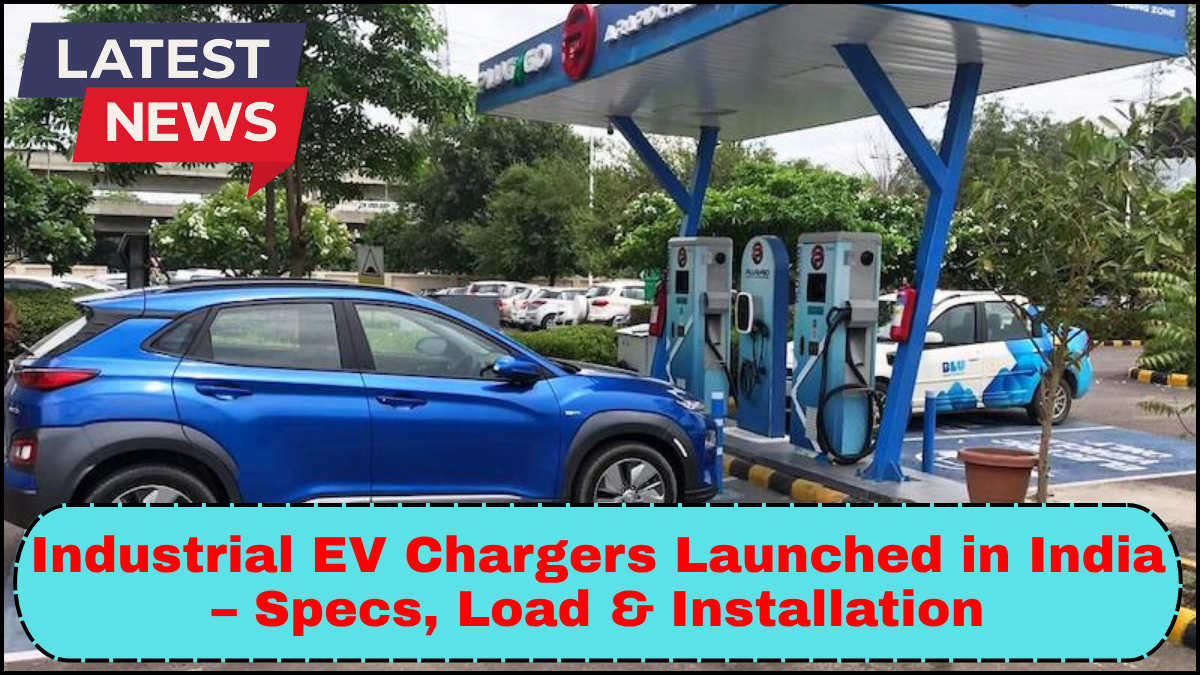India is shifting gears in the EV revolution, and the latest milestone is the launch of industrial EV chargers tailored for large-scale, high-demand use cases. Unlike domestic or commercial chargers, industrial EV chargers are engineered to meet the needs of factories, logistics hubs, fleet operators, and service providers requiring high power and round-the-clock efficiency.

Let’s break down the specifications, load requirements, and installation nuances of these heavy-duty systems.
What Are Industrial EV Chargers?
Industrial EV chargers are robust charging units designed for intensive use. They are built to support high power outputs ranging from 30kW to over 350kW, enabling rapid charging of multiple electric vehicles (EVs) simultaneously. These chargers are ideal for settings like:
- Warehouses
- Transport depots
- Manufacturing facilities
- EV fleet operations
They support both AC and DC charging, but most high-performance variants use DC fast-charging technology to minimize vehicle downtime.
Key Specifications
India’s industrial EV charging units come packed with cutting-edge features. Here are the common technical specs:
- Output Power: 50kW to 350kW (DC fast chargers)
- Input Voltage: Three-phase 400V to 480V
- Current Output: Up to 500 Amps
- Connector Types: CCS2, CHAdeMO, and GB/T
- Charging Protocols: OCPP 1.6/2.0 for smart charging integration
- Cooling System: Air or liquid cooled, depending on capacity
- Compatibility: Supports two-wheelers to heavy-duty electric trucks
These high power systems also feature remote diagnostics, real-time monitoring, and energy usage optimization through cloud platforms.
Load Management and Power Supply Considerations
Installing an industrial EV charger is not just a plug-and-play scenario. It requires an in-depth assessment of the existing electrical infrastructure:
- Power Load Calculation: Industrial units demand significant power. A 150kW charger, for instance, may require up to 200kVA of dedicated load.
- Transformer Capacity: Facilities often need to upgrade or dedicate transformers to support uninterrupted EV charging.
- Smart Load Balancing: Advanced systems can balance power distribution across multiple chargers to avoid grid overloads.
- Backup Systems: Integration with UPS and DG sets for critical operations ensures charging continuity during grid failures.
Installation Requirements
Industrial EV charger installation involves more than wiring. It includes:
- Site Survey: To assess layout, cable routing, and safety compliance.
- Civil Works: Foundation for mounting units, cable trenches, and weatherproofing.
- Electrical Setup: Includes switchgear, MCBs, surge protection, and grounding.
- Networking: Routers, SIM cards, and firewalls for charger-to-cloud communication.
- Regulatory Approvals: DISCOM coordination for additional load sanctioning, and certifications from electrical safety boards.
A typical installation timeline ranges from 4 to 10 weeks, depending on complexity and power availability.
Why Industrial EV Chargers Matter in India
With India targeting 30% EV adoption by 2030, scaling up industrial-grade infrastructure is non-negotiable. The deployment of high power chargers will:
- Accelerate commercial EV fleet adoption
- Enable faster turnaround for logistics operations
- Reduce per-kilometer cost of EV operations
- Support local manufacturing of EV components
Government incentives under FAME-II and state EV policies further ease the cost burden, making adoption feasible for enterprises.
FAQs
Q1. What is the lifespan of an industrial EV charger?
A: Typically 10-15 years, with regular maintenance and software updates.
Q2. Can one charger support different types of vehicles?
A: Yes, multi-standard chargers support multiple connectors and vehicle types.
Q3. Are industrial EV chargers eligible for subsidies?
A: Yes, under the FAME-II scheme and certain state-specific incentives.
Q4. What are the maintenance requirements?
A: Preventive maintenance every 6-12 months and software upgrades as needed.
Q5. Can solar energy be used to power these chargers?
A: Yes, many installations integrate solar + battery systems to offset grid dependency.



